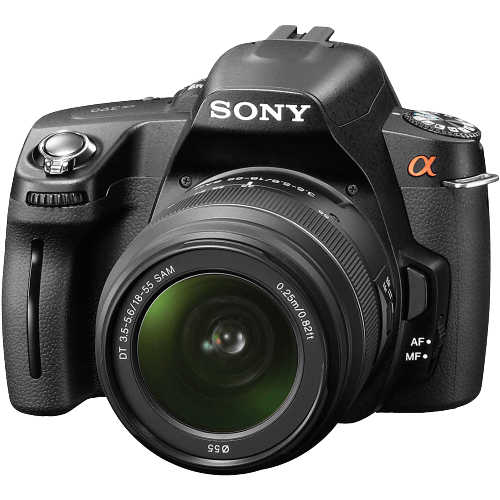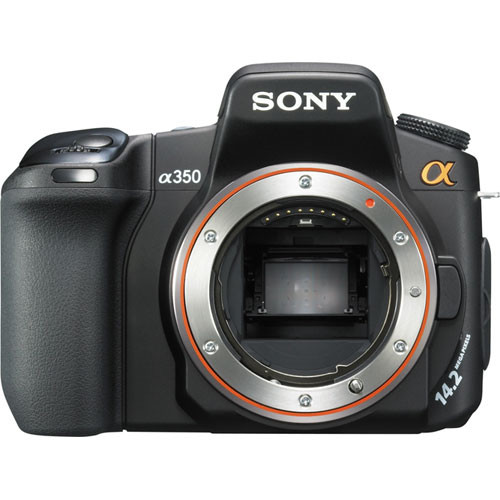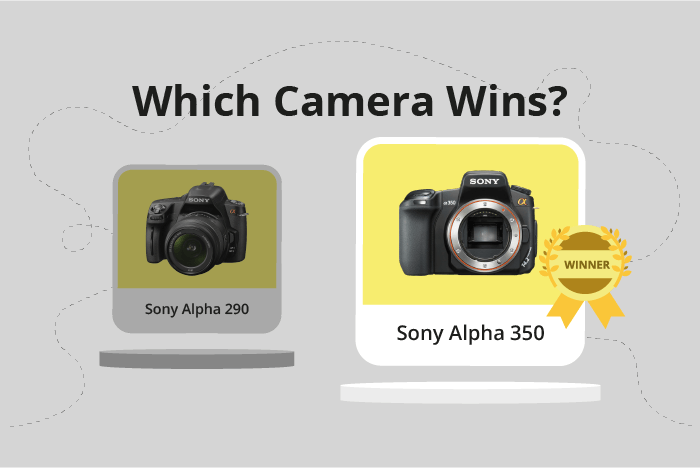Sony Alpha 290 vs Alpha 350 Comparison
Sony Alpha 290

Sony Alpha 350

The Sony Alpha 350 outperforms the Sony Alpha 290 with a score of 44/100 compared to 40/100. Both cameras share similarities as they are both DSLR cameras, released in 2008 and 2010 respectively, and have comparable sizes and weights. The Alpha 350 is superior due to its higher score, which indicates better overall performance. However, the Alpha 290 has some advantages, such as being lighter at 549g compared to 674g and having a lower launch price of $499, compared to the Alpha 350’s $700.
Despite the Alpha 290’s lighter weight and lower price, the Alpha 350 is the better choice due to its higher score, representing better quality and performance.
Sony Alpha 290 vs Alpha 350 Overview and Optics
The Sony Alpha 290 narrowly outperforms the Sony Alpha 350 in terms of optics, scoring 46/100 compared to the latter’s 45/100. Both cameras share several common specifications, including 14.2 megapixels, CCD sensor type, Bionz processor, APS-C sensor size, Sony Alpha DT lens mount, and image stabilization.
The Sony Alpha 290’s edge over the Alpha 350 is due to its slightly higher DXOMARK score for the sensor, which is 66 compared to the Alpha 350’s 65. This means the Alpha 290 has a marginally better sensor performance, which contributes to the overall quality of the images captured.
On the other hand, the Sony Alpha 350 has a faster shooting speed of 3 frames per second (fps), while the Alpha 290 captures at 2.5 fps. This advantage allows the Alpha 350 to capture fast-moving subjects more effectively, making it more suitable for action or sports photography.
In terms of optics, the Sony Alpha 290 is the winner, but only by a small margin. Its higher DXOMARK sensor score indicates slightly better image quality. However, the Sony Alpha 350’s faster shooting speed gives it an advantage in certain situations, such as capturing fast-moving subjects. Both cameras share many similar specifications, so the choice between the two ultimately depends on the specific needs and priorities of the photographer.
Sony Alpha 290 vs Alpha 350 Video Performance
When examining the video capabilities of the Sony Alpha 290 and the Sony Alpha 350, it is important to note that neither camera possesses video functionality. Therefore, there is no difference between the two models in this aspect.
Sony Alpha 290 vs Alpha 350 Features and Benefits
The Sony Alpha 290 and the Sony Alpha 350 both have a feature score of 34/100, making them equal in this aspect. They share several common specifications, such as a 2.7-inch screen size, no touchscreen, a flip screen, and no GPS, WIFI, or Bluetooth capabilities.
Despite their identical feature scores, the Sony Alpha 290 has a slightly higher screen resolution at 230,400 dots, compared to the Alpha 350’s resolution of 230,000 dots. This difference in resolution provides the Alpha 290 with a marginally better display quality.
On the other hand, the Sony Alpha 350 does not have any particular specifications that make it superior to the Alpha 290. Both cameras are quite similar in terms of features, with neither camera offering a clear advantage over the other.
Based on the specifications provided, the Sony Alpha 290 and the Sony Alpha 350 are nearly identical in terms of features, with the Alpha 290 having a slight edge in screen resolution. However, this minor difference is unlikely to significantly impact the overall user experience. As a result, potential buyers should consider other factors, such as price, design, and individual preferences, when choosing between these two cameras.
Sony Alpha 290 vs Alpha 350 Storage and Battery
The Sony Alpha 350 outperforms the Sony Alpha 290 in storage and battery, scoring 65/100 compared to the Alpha 290’s 16/100. Both cameras share some similarities in this aspect, such as accepting Memory Stick Pro Duo / Pro-HG Duo cards and lacking USB charging capabilities.
The Alpha 350 excels with its two memory card slots, supporting Compact Flash (Type I or II), Memory Stick Duo / Pro Duo, UDMA Mode 5, and FAT12 / FAT16 / FAT32 formats. This versatility in memory card compatibility provides more options for photographers. Additionally, the Alpha 350 boasts an impressive battery life of 730 shots, more than double the Alpha 290’s 290 shots, using the NP-FM500H battery type.
In contrast, the Alpha 290 only has one memory card slot and accepts SD / SDHC cards alongside Memory Stick Pro Duo / Pro-HG Duo. Its battery life is significantly shorter, relying on the NP-FH50 battery type. There is no apparent advantage for the Alpha 290 in storage and battery aspects.
Taking these factors into account, the Sony Alpha 350 proves to be a superior choice for photographers seeking extended battery life and more storage options. The Alpha 290 falls short in this comparison, offering limited memory card compatibility and a shorter battery life.
Sony Alpha 290 vs Alpha 350 – Our Verdict
Are you still undecided about which camera is right for you? Have a look at these popular comparisons that feature the Sony Alpha 290 or the Sony Alpha 350:

